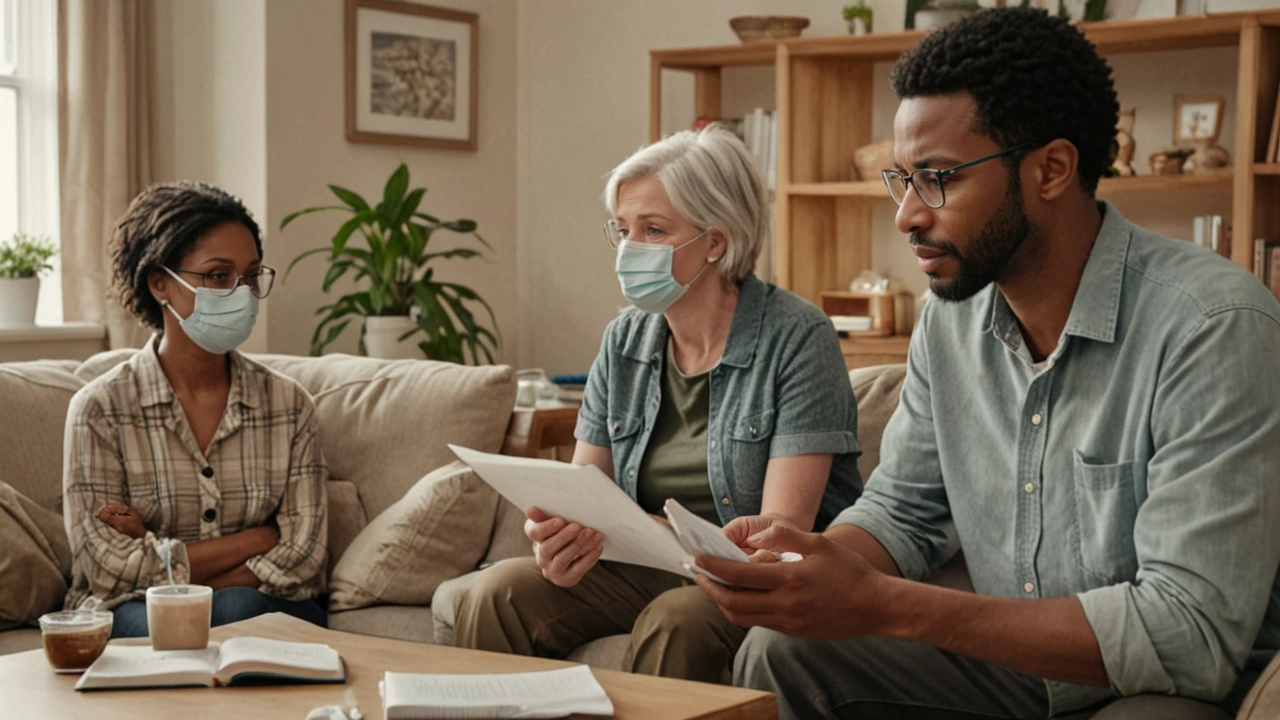
The world was caught off guard by the COVID-19 pandemic, a crisis that didn't just affect physical health but also mental well-being. This phenomenon has left many wondering how pandemic stress and uncertainty have reshaped our collective consciousness.
The sudden halt to normal life, social isolation, and fear of illness created a perfect storm for mental health issues to thrive. The need to adapt quickly to new norms like remote work and virtual schooling added layers of stress and anxiety for many. But beyond these immediate impacts, the pandemic also revealed the underlying cracks in our mental health support systems.
Across age groups, from children to the elderly, the pandemic's challenges manifested in unique ways. While young children struggled with the loss of social interactions, teenagers faced disruptions in their education and critical life milestones. Adults found themselves juggling work, family responsibilities, and a constant barrage of worrying news.
Communities worldwide experienced varying degrees of mental strain, often influenced by existing socio-economic conditions. For instance, frontline workers, people of color, and those in lower-income brackets were hit hardest, exacerbating pre-existing mental health disparities.
Amidst all this, mental health organizations and professionals began to pivot, offering teletherapy and online support groups. These resources became lifelines for many, providing coping strategies for managing stress and anxiety during these unprecedented times. Simple but effective tips like establishing a daily routine, staying connected virtually, and practicing mindfulness have been pivotal in maintaining mental wellness.
As we look to the future, it's crucial to understand and address the long-term impacts of the pandemic on mental health. There's a need for more robust mental health services and policies, ensuring everyone gets the help they need.
- The Psychological Effects of COVID-19
- Challenges Faced by Different Age Groups
- Mental Health in Various Communities
- Coping Strategies and Resources
- Future Outlook for Mental Health
The Psychological Effects of COVID-19
The COVID-19 pandemic thrust the world into a state of uncertainty and fear, affecting not only physical health but also mental wellness. The sudden and prolonged upheaval has left many grappling with anxiety, depression, and stress. Studies have shown a significant rise in mental health issues, showcasing how deeply the crisis impacted our psychological state.
One of the most immediate effects was the widespread feeling of **anxiety**. People worried about their health, the health of loved ones, financial stability, and the future. For many, this constant state of worry triggered stress-related symptoms such as insomnia, headaches, and even panic attacks. Children and teenagers, who usually rely on routine and social interaction, experienced heightened levels of anxiety due to school closures and the loss of normal activities.
Depression also spiked during the pandemic. Social isolation, quarantine measures, and lockdowns led to feelings of loneliness and hopelessness. Humans are inherently social creatures, and being cut off from friends, family, and communities exacerbated these negative emotions. The lack of physical contact and the inability to engage in normal social activities made it particularly challenging for individuals who were already vulnerable or had pre-existing mental health conditions.
"The COVID-19 pandemic has triggered a 25% increase in the prevalence of anxiety and depression worldwide." - World Health Organization
Substance abuse became another troubling effect. Many people turned to **alcohol** and drugs as a coping mechanism for the ongoing stress and uncertainty. This coping strategy might offer temporary relief but often leads to more severe mental health issues in the long run. The closure of rehabilitation centers and therapy services during the early phases of the pandemic left many individuals without the support they desperately needed.
Sleep patterns also saw a drastic change. The stress and anxiety of the pandemic disrupted circadian rhythms, leading to insomnia or irregular sleep patterns. People found it challenging to maintain a regular sleep schedule, which further impacted their mental health. The lack of restful sleep added another layer of complexity to managing daily tasks and maintaining overall wellness.
For those with existing mental health issues, the pandemic acted as a trigger that worsened their conditions. Patients with obsessive-compulsive disorder (OCD), for instance, found their symptoms exacerbated due to the heightened focus on hygiene and virus prevention. Similarly, individuals with social anxiety faced new challenges with the shift to virtual interactions, which can be just as daunting as face-to-face interactions for some.
An interesting observation was the impact on healthcare workers and frontline personnel. These individuals faced the twin burdens of long hours and witnessing the devastating effects of the virus firsthand. Many suffered from **burnout**, post-traumatic stress disorder (PTSD), and severe anxiety. Their mental health became as much of a concern as their physical well-being.
Understanding the Long-Term Effects
The long-term psychological effects of COVID-19 are still being studied, but early research suggests that we could see lasting impacts for years to come. The collective trauma experienced during the pandemic has the potential to lead to a rise in chronic mental health conditions. Communities and policymakers must prioritize mental health resources to support ongoing recovery efforts.
Challenges Faced by Different Age Groups
Different age groups faced unique mental health challenges during the COVID-19 pandemic. For children, the abrupt shift from classroom learning to virtual schooling was disorienting. They lost daily face-to-face interactions with friends, which are crucial for their social and emotional development. Parents also found it difficult to balance work commitments with overseeing their children's education at home. Mental health professionals noticed a rise in symptoms of anxiety and depression among children, who struggled to understand the changes around them.
Teenagers, on the other hand, faced their own unique set of issues. High school years are pivotal for personal growth and social interaction. The cancellation of milestone events like graduations and proms left many feeling a sense of loss. College-bound students had to adapt to online transfers and new protocols, leading to increased stress and uncertainty about their futures. A study by the Centers for Disease Control and Prevention (CDC) noted a significant increase in mental health issues among older teens and young adults during the pandemic.
Adults were not spared from the psychological impact of COVID-19. With the shift to remote work, many found themselves grappling with feelings of isolation and increased workloads. Parents had the added pressure of caring for children who were home all day. Financial instability due to furloughs and job losses exacerbated stress levels. Additionally, adults had to cope with the constant influx of troubling news, which added to their anxiety and depression.
For the elderly, the pandemic presented a different set of challenges. Many seniors experienced heightened loneliness due to the necessary social distancing measures. Visits from family members were limited, leaving them without their usual support networks. Concerns about their health and susceptibility to the virus further fueled anxiety. Despite these challenges, resilience was seen within this age group, with many finding solace in virtual gatherings and new hobbies.
“We have to acknowledge the multifaceted impact of this pandemic on mental health. It is a wake-up call to provide better mental health support tailored to different age groups,” stated Dr. Maria Thompson, a renowned psychologist.
Mental health professionals and organizations stepped up their efforts to address these varied needs. Offering virtual counseling and creating age-specific support groups became critical components in helping people cope. Recognizing the specific issues faced by different age groups is essential in crafting effective mental health strategies moving forward. By understanding their unique challenges, society can work towards building more robust support systems that cater to everyone's needs, ensuring no one is left behind.

Mental Health in Various Communities
The COVID-19 pandemic had profoundly different impacts on the mental health of various communities worldwide. Understanding these differences is key to providing effective support and resources. One clear trend was that the socio-economically disadvantaged and marginalized groups experienced a more pronounced mental health toll.
Frontline workers, for instance, faced immense pressure and anxiety. They worked long hours and were constantly exposed to the virus, which significantly affected their mental well-being. The constant fear of infection, coupled with the stress of being away from families, made their mental health deteriorate. Mental health professionals reported a notable increase in anxiety, depression, and burnout within this group. This was highlighted in numerous reports and studies during the pandemic.
Notably, communities of color were disproportionately affected. African American and Hispanic communities, already contending with higher rates of COVID-19 infection and mortality due to socio-economic factors, also experienced greater mental health impacts. The additional stress of witnessing the disparity in healthcare and systemic inequities exacerbated feelings of helplessness and frustration.
Lower-income families faced unique challenges during the pandemic. Many were unable to work remotely, putting them at greater risk for exposure to the virus. Job loss and financial insecurity added layers of stress and anxiety, impacting their mental health significantly. In addition, access to mental health resources is often limited in these communities, creating barriers to getting help.
Moreover, children and teenagers from these communities struggled with remote learning due to a lack of digital access, creating an academic gap and additional stress. Mental health issues among young people rose, as they lacked the necessary support and resources to cope with the sudden changes brought by the pandemic.
Rural communities also faced particular strains. The isolation, lack of healthcare infrastructure, and limited internet access made it difficult for residents to access mental health services. Many of these communities rely heavily on in-person interactions, which were curtailed by the pandemic. This isolation worsened feelings of loneliness and depression.
Another group deeply impacted was the elderly. Social isolation, fear of infection, and the risk of severe illness increased anxiety and depression among older adults. Many were cut off from their social networks and support systems, amplifying feelings of loneliness. According to a study by the National Institute on Aging, there was a significant increase in mental health issues among the elderly during the pandemic.
"The pandemic has unveiled and exacerbated existing inequalities within our mental health systems," said Dr. Vivek Murthy, U.S. Surgeon General. "Addressing these disparities requires concerted effort and sustained investment in mental health infrastructure."
Mental health organizations and community groups have been essential in offering support. Initiatives like teletherapy, virtual support groups, and community outreach programs have provided some relief. Still, much work remains to be done to ensure equitable mental health care for all communities.
Coping Strategies and Resources
One of the first steps to managing mental health during the COVID-19 pandemic involves embracing practical coping strategies. For many people, creating a daily routine has been essential. Routines help bring a sense of normalcy and control. Whether it's setting a regular wake-up time, designating work hours, or planning family activities, these small steps can make a big difference. Establishing a consistent routine helps reduce stress and anxiety by providing a structured environment.
Another crucial strategy is to stay connected with loved ones. Social isolation has been one of the most challenging aspects of the pandemic, and maintaining virtual connections through video calls and social media can alleviate feelings of loneliness. Studies show that regular social interaction is linked to lower levels of stress and improved mood. It's important to schedule regular check-ins with friends and family, fostering a sense of community even while physically apart.
Mental health professionals have also adapted to the new normal by offering teletherapy. Online counseling and support groups have become more accessible, providing a safe space for individuals to express their feelings and receive professional guidance. If you're struggling, it's crucial to seek help from a licensed therapist. Many platforms offer affordable options for online therapy, making mental health support more attainable for everyone. This shift towards teletherapy has been a game-changer for many, allowing people to access help from the comfort of their homes.
Introducing mindfulness practices, such as meditation and yoga, into daily routines can also have a profound effect on mental health. These activities help calm the mind and reduce stress levels. There are numerous apps and online resources available that offer guided meditations and yoga sessions, making it easy to get started. Mindfulness practices encourage individuals to stay present and focused, promoting a greater sense of inner peace.
Healthy Lifestyle Choices
Maintaining a healthy lifestyle is another key aspect of managing mental health. Regular exercise, a balanced diet, and adequate sleep all contribute to overall well-being. Physical activity releases endorphins, which are natural mood lifters. Aim for at least 30 minutes of exercise most days of the week. A diet rich in fruits, vegetables, lean proteins, and whole grains supports both physical and mental health. Proper sleep hygiene, such as establishing a sleep schedule and creating a relaxing bedtime routine, ensures restorative rest.
Stress management techniques are also vital. Activities like journaling, drawing, or engaging in hobbies can provide an emotional release. Practicing gratitude, by writing down things you're thankful for, can shift focus away from negative thoughts. Engaging in activities that bring joy and fulfillment helps counteract feelings of anxiety and depression.
Community Resources
Many communities have rallied to provide additional mental health resources during the pandemic. Local support groups, hotlines, and online forums offer spaces for individuals to share their experiences and find support. Community centers and organizations often provide free or low-cost mental health services. It’s worth exploring local resources to discover what's available in your area.
“In times of crisis, community becomes the backbone of resilience,” said Dr. Sarah Johnson, a renowned psychologist. “Connecting with others, even virtually, can provide immense comfort and strength.”
Additionally, national and international organizations have launched initiatives to support mental health. The World Health Organization (WHO) and Centers for Disease Control and Prevention (CDC) offer a wealth of information and resources on coping with pandemic-related stress. These reputable sources can provide guidance and tips for managing mental health.
By incorporating these coping strategies and utilizing available resources, individuals can better navigate the mental health challenges brought by COVID-19. Finding the right tools and support systems is essential for building resilience and maintaining well-being in these unprecedented times.

Future Outlook for Mental Health
As we move forward from the COVID-19 pandemic, it's essential to consider how our collective mental health has been reshaped and what the future holds. Experts agree that the psychological toll from the pandemic will persist long after the virus is under control. Increased awareness about mental wellness can lead to a more supportive and understanding society, but this requires active efforts from both individuals and governing bodies.
One significant change is the growing acceptance and utilization of teletherapy. During the pandemic, mental health professionals quickly adapted to online platforms, providing remote counseling and therapy sessions. This shift made mental health services more accessible to people who might have otherwise faced barriers such as physical distance or social stigma. Studies have shown that teletherapy can be just as effective as in-person sessions for many conditions, and this trend is expected to continue.
Another likely development is the enhancement of workplace mental health programs. Employers recognized that the mental well-being of their employees directly impacts productivity and overall job satisfaction. Many companies are now investing in comprehensive mental health benefits, including therapy coverage, mental health days, and wellness programs. These measures are not only a response to immediate needs but also an investment in a healthier, more resilient workforce.
Children and teenagers, having faced unique challenges during the pandemic, will also require ongoing support. Educational systems have begun integrating mental health education into their curriculums, teaching students coping strategies, resilience, and the importance of seeking help when needed. More schools are employing counselors and psychologists to address these issues proactively.
Community-based support will play a crucial role in the future of mental health. Grassroots organizations and local initiatives provide culturally relevant support, reaching those who might be overlooked by mainstream services. By fostering environments where mental health is openly discussed and supported, communities can reduce stigma and encourage more people to seek assistance.
On a policy level, there's a growing push for better mental health funding and regulations. Governments are recognizing the importance of integrating mental health care into public health systems. This involves training primary care doctors to identify and treat mental health issues, expanding insurance coverage, and building more mental health facilities. These measures aim to create a more equitable system where everyone has access to the care they need.
The pandemic has also highlighted the need for research into the long-term effects of COVID-19 on mental health. Understanding these impacts will help develop better treatments and interventions. For instance, some studies suggest that those who recovered from severe COVID-19 cases might experience ongoing psychological symptoms like anxiety and depression. Addressing these issues requires a multidisciplinary approach, combining medical, psychological, and social support.
According to the World Health Organization, "mental health services are an essential part of all government responses to COVID-19." This statement underscores the need for a coordinated effort to ensure mental health remains a priority.
As we rebuild and move toward a post-pandemic world, it's important to remember that mental health is a lifelong journey. The lessons learned during this time can lead to a more compassionate and supportive society, equipped to handle future challenges. Whether through teletherapy, school programs, community support, or policy changes, the future of mental health looks toward a more inclusive and accessible approach.





